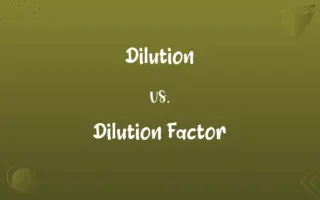Top-Down Approach vs. Bottom-Up Approach: Know the Difference

By Dua Fatima & Shumaila Saeed || Published on March 6, 2024
The top-down approach starts with the big picture and breaks it down into smaller components, while the bottom-up approach begins with the details, building them up to form a comprehensive view.

Key Differences
In a top-down approach, planning and decision-making start at the highest level, focusing on system architecture and high-level functionalities before drilling down to specifics. Conversely, the bottom-up approach emphasizes detailed-level tasks and components, which are then integrated into a cohesive whole, highlighting the importance of foundational elements.
Dua Fatima
Mar 06, 2024
The top-down method is often used in project management and software development, where strategic objectives guide the decomposition of tasks. In contrast, bottom-up is favored in contexts requiring detailed understanding and innovation from the ground up, such as grassroots movements or organic team development, showcasing each approach's adaptability to different organizational needs.
Shumaila Saeed
Mar 06, 2024
In software engineering, a top-down approach might begin with defining major functions, then specifying smaller subsystems, promoting clarity and foresight. Bottom-up, however, starts with developing small modules or components, which are tested and then integrated, fostering creativity and immediate problem-solving.
Dua Fatima
Mar 06, 2024
The top-down strategy is characterized by its emphasis on control and direction from the top, making it suitable for environments where clear objectives and a defined path are essential. The bottom-up strategy thrives on flexibility and the contributions of individual elements, making it ideal for innovation and when outcomes are less predictable.
Shumaila Saeed
Mar 06, 2024
Top-down can sometimes overlook ground-level insights, leading to potential disconnects between planning and implementation, bottom-up approaches might lack overall direction, risking inefficiency or misalignment with broader goals. Balancing elements of both strategies can lead to a more holistic and effective approach to projects and problem-solving.
Dua Fatima
Mar 06, 2024
ADVERTISEMENT
Comparison Chart
ADVERTISEMENT
Top-Down Approach and Bottom-Up Approach Definitions
Top-Down Approach
Emphasizes strategic planning from the top.
Senior management develops a new product strategy before any design starts.
Shumaila Saeed
Feb 26, 2024
Bottom-Up Approach
Builds from the bottom, aggregating details into a comprehensive plan.
A community group develops a policy proposal based on member input.
Dua Fatima
Feb 26, 2024
Top-Down Approach
Begins with overarching goals, breaking them into smaller tasks.
A company outlines its annual goals and then plans specific projects.
Dua Fatima
Feb 26, 2024
Bottom-Up Approach
Can lead to emergent strategies without centralized planning.
Grassroots movements form a national agenda through local initiatives.
Shumaila Saeed
Feb 26, 2024
Top-Down Approach
Relies on hierarchical structure for implementation.
A construction project is planned by architects and engineers before work commences.
Shumaila Saeed
Feb 26, 2024
ADVERTISEMENT
Bottom-Up Approach
Fosters detailed understanding and specialization.
Scientists conduct experiments to form a broader theory.
Dua Fatima
Feb 26, 2024
Top-Down Approach
Suitable for large-scale project management.
Organizing a national campaign by defining key messages and tactics.
Dua Fatima
Feb 26, 2024
Bottom-Up Approach
Enhances adaptability to changes and feedback.
A start-up pivots its business model based on early user experiences.
Shumaila Saeed
Feb 26, 2024
Top-Down Approach
Can streamline decision-making processes.
A software project is structured around major functionalities before coding begins.
Dua Fatima
Feb 26, 2024
Bottom-Up Approach
Empowers lower-level contributions and innovation.
A tech team prototypes features, which inform the product development.
Shumaila Saeed
Feb 26, 2024
Repeatedly Asked Queries
How do approaches vary in decision-making?
Top-down features centralized decision-making, while bottom-up distributes decision authority among lower levels.
Dua Fatima
Mar 06, 2024
How does the bottom-up approach benefit innovation?
By valuing ground-level insights and flexibility, it encourages creativity and practical solutions.
Shumaila Saeed
Mar 06, 2024
Which approach is better for managing complex projects?
The top-down approach is typically preferred for its clear structure and direction, though complexity might also benefit from the adaptability of the bottom-up approach.
Shumaila Saeed
Mar 06, 2024
Is one approach faster than the other?
Top-down can be quicker in establishing direction, but bottom-up might accelerate innovation and problem-solving.
Shumaila Saeed
Mar 06, 2024
Can a project switch approaches midway?
Yes, projects might start with one approach and switch to the other as needed for strategic reevaluation or to incorporate insights.
Shumaila Saeed
Mar 06, 2024
Can the top-down and bottom-up approaches be combined?
Yes, combining both can leverage strategic oversight and detailed innovation, often leading to more effective outcomes.
Dua Fatima
Mar 06, 2024
How does each approach affect stakeholder engagement?
Top-down might limit engagement to higher levels, whereas bottom-up encourages wider participation and feedback.
Dua Fatima
Mar 06, 2024
Which approach is better for organizational change?
Bottom-up can be more effective for change initiatives, as it allows for input and buy-in from all levels.
Shumaila Saeed
Mar 06, 2024
How do these approaches relate to risk management?
Top-down allows for centralized risk assessment, while bottom-up can identify and mitigate risks at the operational level.
Dua Fatima
Mar 06, 2024
Which approach is more suitable for startups?
Startups may favor the bottom-up approach for its adaptability and emphasis on innovation.
Dua Fatima
Mar 06, 2024
What is the main advantage of the top-down approach?
It provides clear strategic direction and oversight, ensuring alignment with overarching goals.
Dua Fatima
Mar 06, 2024
How do these approaches impact organizational culture?
Top-down can foster a culture of order and efficiency, while bottom-up may encourage creativity and empowerment.
Dua Fatima
Mar 06, 2024
What is a common criticism of the top-down approach?
It can sometimes miss out on valuable insights from lower levels, leading to less effective solutions.
Shumaila Saeed
Mar 06, 2024
Why might the bottom-up approach be challenging to implement?
It requires effective coordination and communication to ensure cohesion and alignment with broader goals.
Dua Fatima
Mar 06, 2024
What is a key factor in choosing between these approaches?
The decision often depends on the project's scope, goals, and the desired balance between control and innovation.
Hifza Nasir
Mar 06, 2024
Share this page
Link for your blog / website
HTML
Link to share via messenger
About Author
Written by
Dua FatimaCo-written by
Shumaila SaeedShumaila Saeed, an expert content creator with 6 years of experience, specializes in distilling complex topics into easily digestible comparisons, shining a light on the nuances that both inform and educate readers with clarity and accuracy.








































































